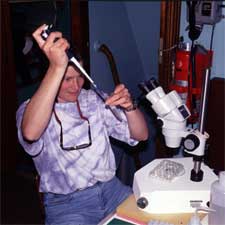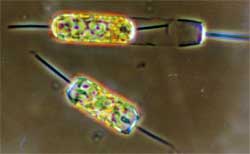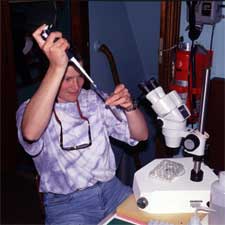
to assess how plankton respond to changing environment
Research has implications for understanding impact of global warming
NARRAGANSETT, R.I. – November 20, 2007 – Single celled diatoms are found abundantly in every body of water on Earth, and they are responsible for about 40 percent of all of the photosynthesis that occurs in the world’s oceans.
“That means they have a major impact on Earth’s climate, because they take up a lot of carbon dioxide and release a lot of oxygen,” explained Tatiana Rynearson, assistant research professor at the University of Rhode Island. “But we don’t know how these diatoms are going to respond as their environment changes.”
 To examine this question, Rynearson has been awarded an $852,000 grant from the National Science Foundation to study the biogeography of plankton – their distribution in space and time.
To examine this question, Rynearson has been awarded an $852,000 grant from the National Science Foundation to study the biogeography of plankton – their distribution in space and time.
“These single cells are incredibly diverse and survive in a remarkable variety of habitats,” said Rynearson, who joined the faculty of URI’s Graduate School of Oceanography in 2005 after earning her Ph.D. at the University of Washington. “We need to know how diatoms thrive in different environments and then maybe we can say something about their ability to adapt to climate change.”
Rynearson is collecting diatoms in water samples from around the world, including in the waters off South Africa, Italy, Japan, Norway, Mexico, Australia and Russia, as well as from along the U.S. coastline. She then uses DNA fingerprint techniques “to look at the highways and byways in the ocean, to see where the diatoms are going, where they’re coming from, and how well they do once they get there,” she explained.
The URI professor pioneered the use of DNA fingerprinting of diatoms, and she was part of the first team to sequence the genome of a diatom.
While there may be up to 200,000 species of diatoms around the world, Rynearson’s research is focusing on just three species as bio-indicators. She hopes to learn whether physical or environmental barriers exist that prevent diatoms from moving from one place to another.
Working in collaboration with biologists from the Census of Marine Life and international colleagues who are conducting long-term plankton surveys in many places around the world, Rynearson is comparing diatom populations to determine the amount of genetic exchange that occurs between populations. She has even enlisted the help of a robot to process hundreds of cells at a time.
As part of the five-year project, she will also grow diatoms in her lab under varying conditions in an effort to understand the genetic adaptations that allow diatoms to flourish in today’s environment and to predict how populations will respond to environmental changes in the future.
Pictured above
URI Assistant Professor Tatiana Rynearson prepares to examine diatoms
under a microscope while shipboard in Puget Sound, Washington.
Magnified view of a diatom as seen through a microscope.

